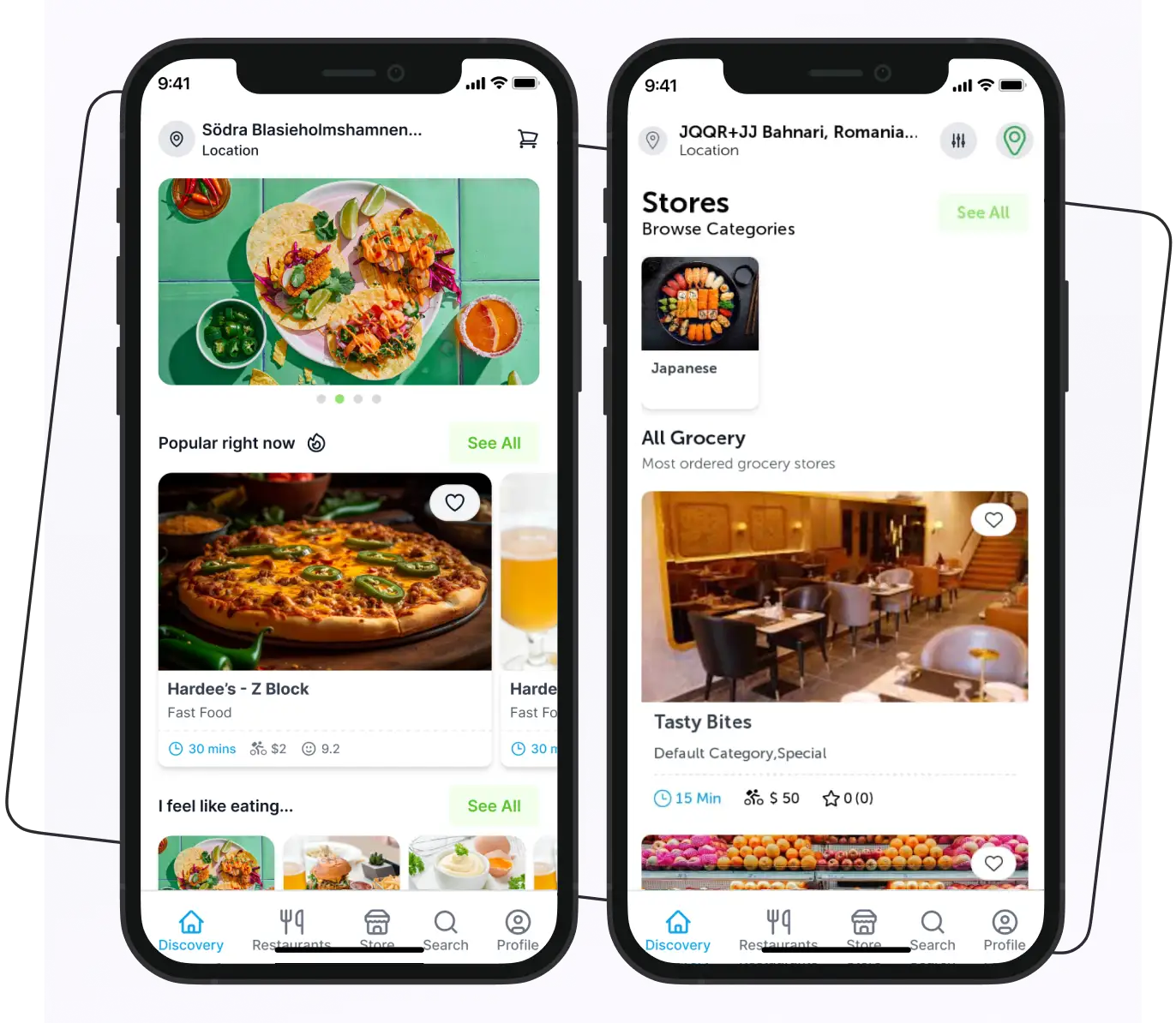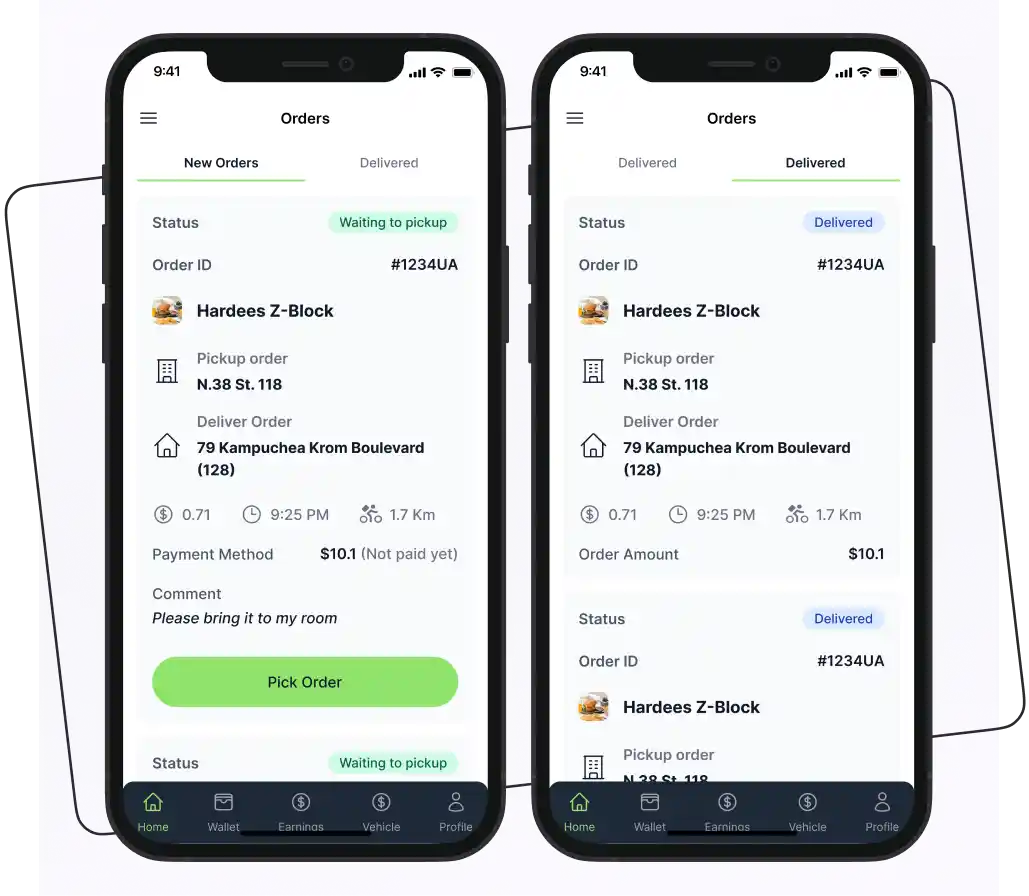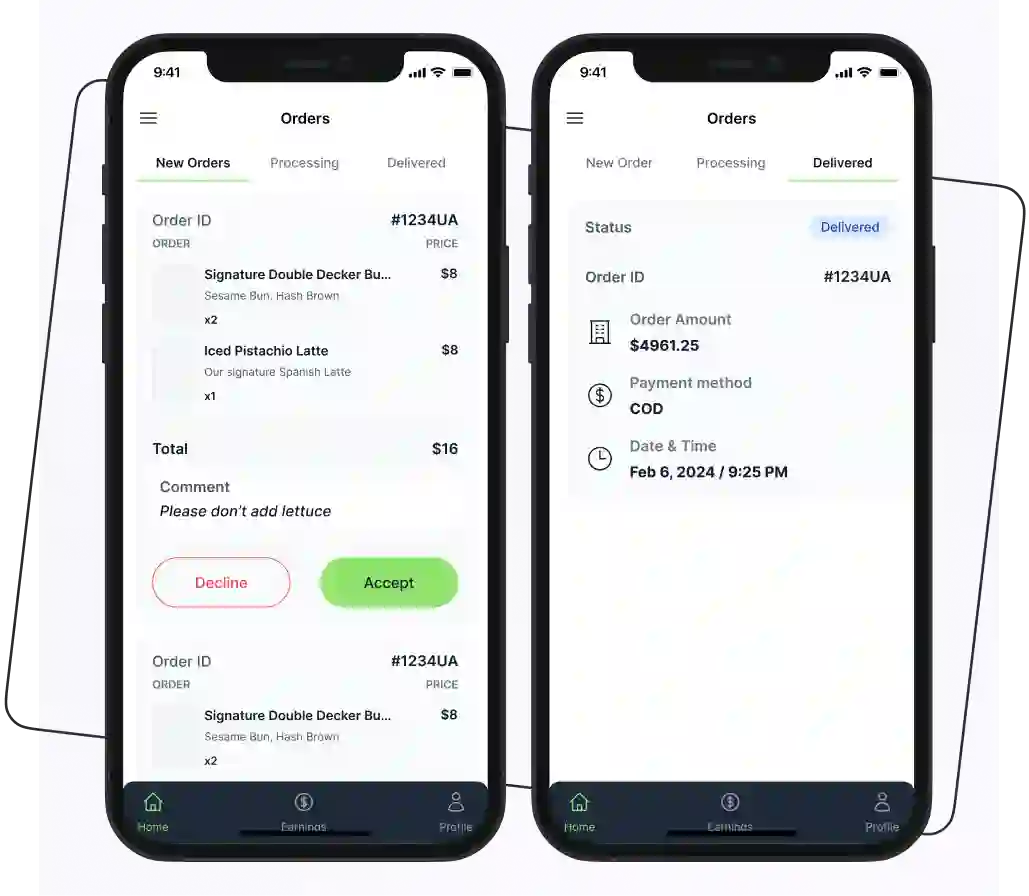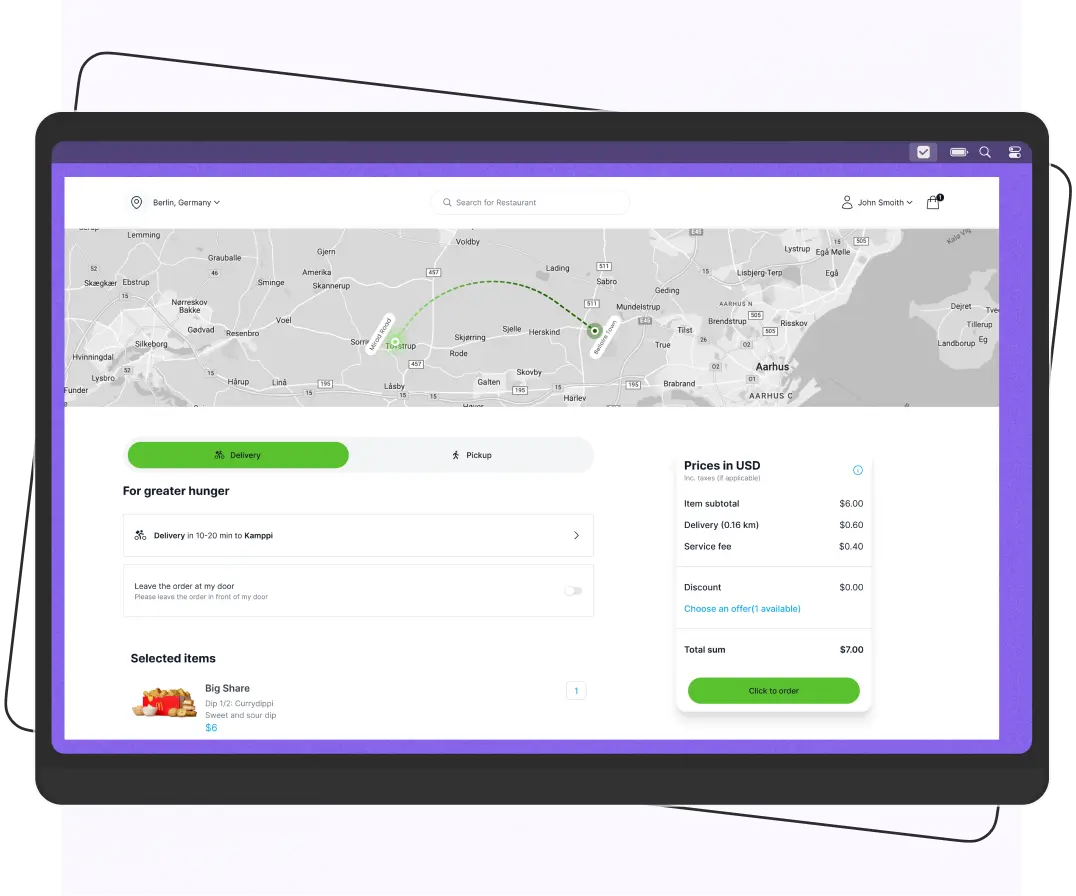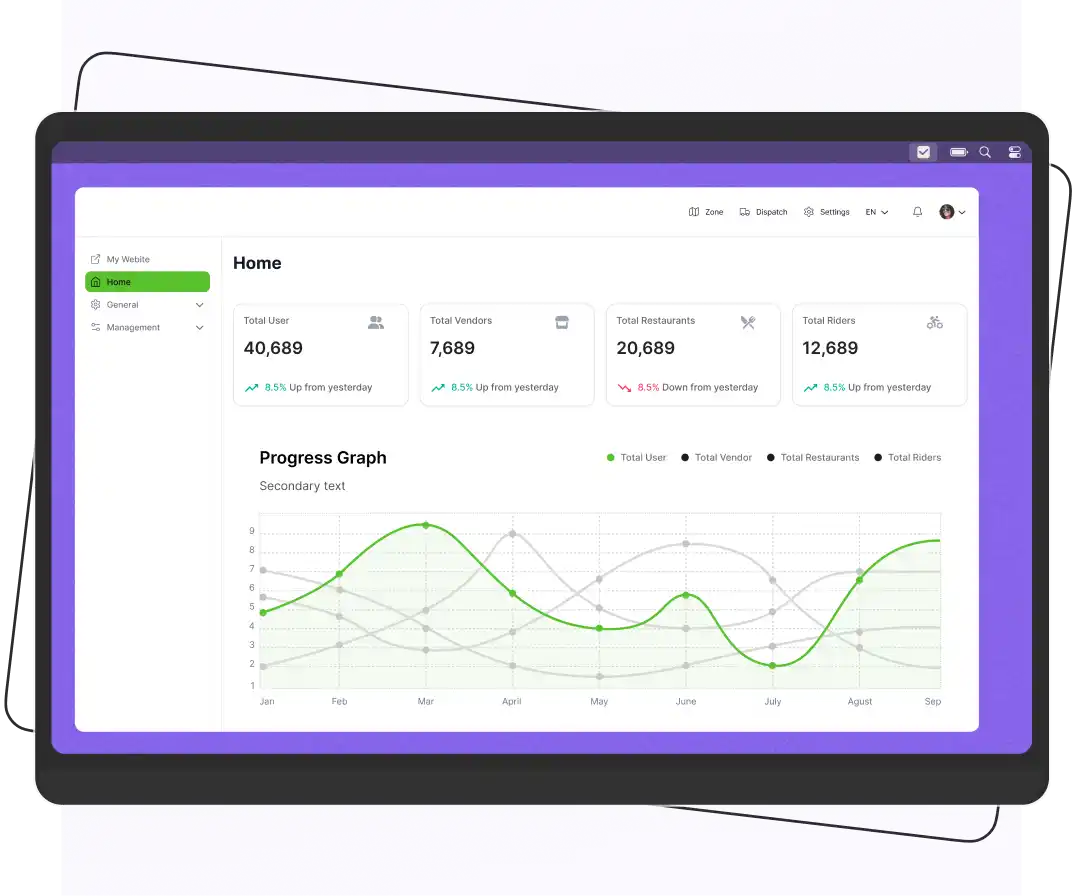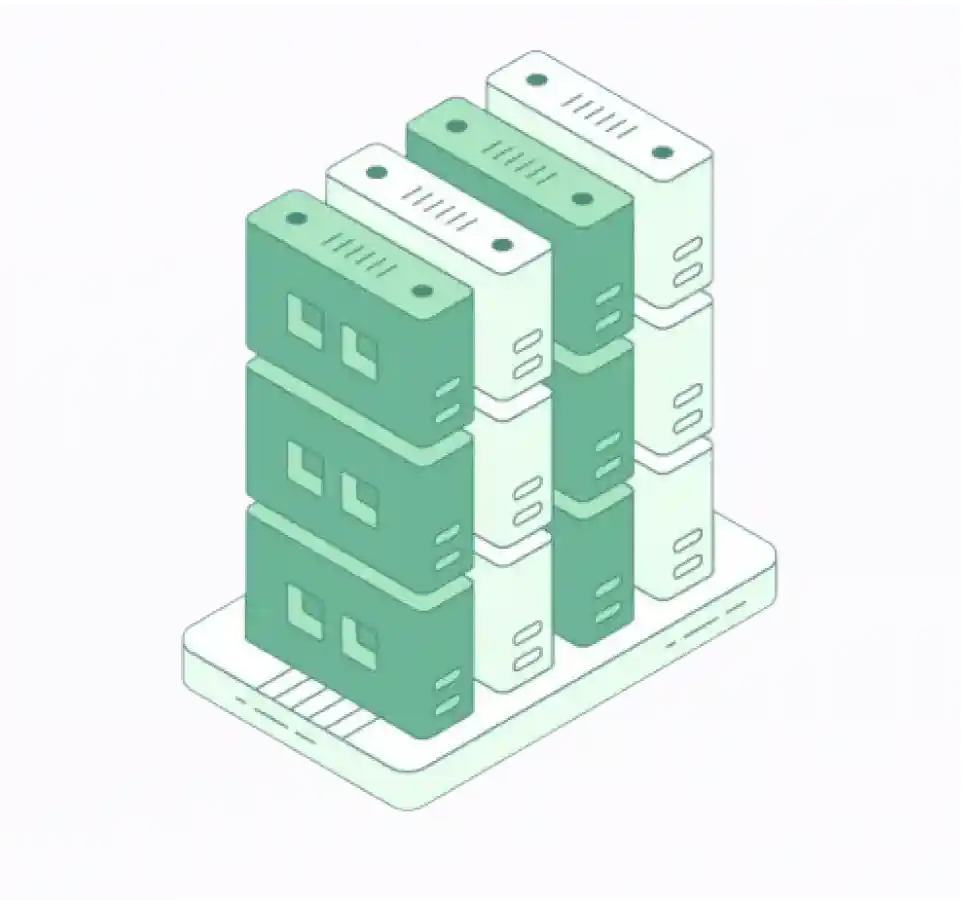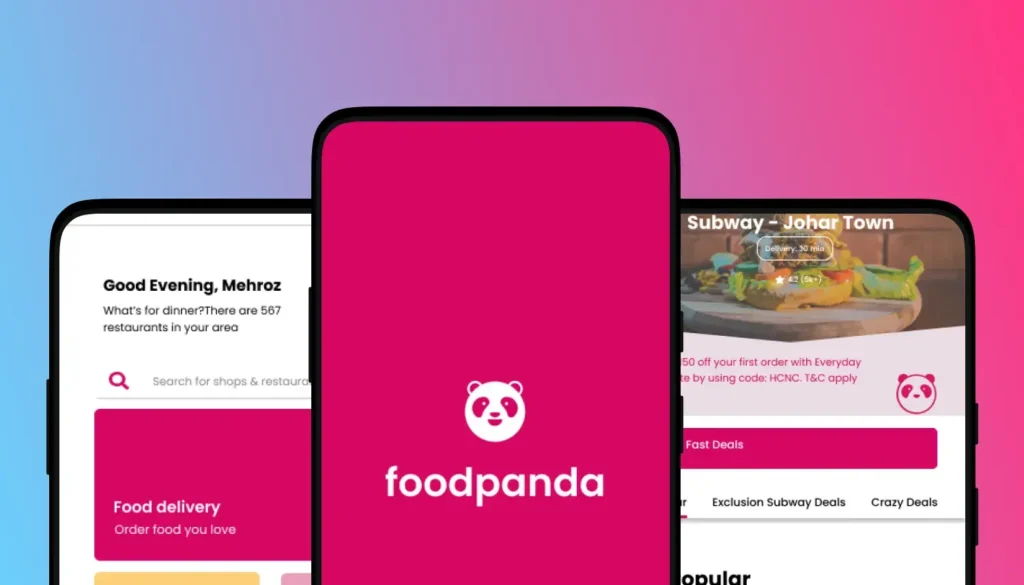
Do you want to know how much it costs to build a delivery app like Foodpanda, UberEats, Grubhub, and DoorDash? Guess what, you’re at the right place.
In 2024, the global food delivery market is rapidly growing, driven by the convenience and speed that apps like Foodpanda, UberEats, and DoorDash offer. With 59% of restaurant orders now coming from takeout or delivery, the demand for seamless, user-friendly apps is at an all-time high.
The revenue of the food delivery market is expected to reach $1.65 trillion by 2027, according to Statista.
But what does it take to build a food delivery app that stands out in this booming industry? In this blog, we break down the cost ranging from $30,000 to $150,000 depending on your chosen features, tech stack, and region.
So, let’s explore and get a clearer picture of the investment required in building the food app.
How Much Does It Cost to Build a Food Delivery App?
The cost of creating the food delivery app depends on several factors such as app features, complexity, development team location, and more.
Look at the below table and know the exact cost of developing the food app.
| Basic App (Online ordering, user registration, payment integration) | $20,000 – $35,000 |
| Intermediate App (Real-time order tracking, loyalty programs, advanced analytics) | $35,000 – $60,000 |
| Advanced App (AI integration, augmented reality, high customization) | $60,000 – $100,000+ |
Cost to Build a Food Delivery App by Regions
The below table shows the cost of building a food delivery app according to different regions.
| Cost Component | North America | Europe | Asia | Latin America |
| App Development (iOS and Android) | $150,000 – $300,000 | $120,000 – $250,000 | $90,000 – $180,000 | $80,000 – $150,000 |
| Backend Development | $80,000 – $150,000 | $70,000 – $120,000 | $50,000 – $100,000 | $40,000 – $80,000 |
| UI/UX Design | $30,000 – $60,000 | $25,000 – $50,000 | $20,000 – $40,000 | $15,000 – $30,000 |
| Server Hosting and Infrastructure | $5,000 – $15,000/year | $4,000 – $12,000/year | $3,000 – $10,000/year | $2,500 – $8,000/year |
| Third-party integrations (payment gateways, maps, etc.) | $15,000 – $30,000 | $12,000 – $25,000 | $10,000 – $20,000 | $8,000 – $15,000 |
| Marketing and Advertising | $50,000 – $150,000/year | $40,000 – $120,000/year | $30,000 – $80,000/year | $20,000 – $60,000/year |
Supercharge your deliveries with Enatega.
Get Started NowHow Long Does It Take to Build a Delivery App?
The below table shows the estimated time required for app building.
| Complexity | App Development Timeline |
| Simple app development | 2-4 months |
| Average app development | 4-6 months |
| Complex app development | 10+ months |
Food Delivery App Development Cost: Based on Popular Food Delivery Apps
The cost to develop a food delivery app like Postmates, UberEats, or Grubhub can vary based on several factors, including features, platform (iOS, Android, or both), location of the development team, complexity of the app, etc.
Here is the estimated cost of these apps.
Cost to Build an App Like Postmates
- Estimated Cost: $50,000 – $250,000
- Key Features
- User registration and profiles
- Restaurant listing and menu
- Real-time order tracking
- Payment gateway integration
- Ratings and reviews
- Admin panel for managing orders
Cost to Build an App Like UberEats
- Estimated Cost: $70,000 – $300,000
- Key Features
- User-friendly interface for food discovery
- Advanced search and filters
- In-app chat for customer support
- Scheduled deliveries
- Loyalty programs and discounts
- Comprehensive analytics for restaurant partners
Cost to Build an App Like Grubhub
- Estimated Cost: $60,000 – $250,000
- Key Features
- User and restaurant registration
- Order management system
- Multiple payment options
- Push notifications for order updates
- User reviews and feedback system
- Integration with third-party services (e.g., GPS)
Factors Affecting the Cost of Building a Food Delivery App
The cost of developing a food app can depend on several key factors, including:
App Complexity
The more complex the app features and functionalities, the higher the development cost.
Platform Choice
Developing for multiple platforms (iOS, Android, web) will typically cost more than a single platform implementation. Cross-platform frameworks can help reduce costs compared to building native apps for each OS.
Design and UX
A polished, user-friendly design with a great UX can require significant investment in UI/UX design, prototyping, and iterative development.
Backend Infrastructure
The cost of setting up and maintaining the backend servers, databases, APIs, etc. can be an important factor, especially for apps with high user volumes and complex data requirements.
Third-Party Integrations
Integrating features like payment gateways, loyalty programs, delivery services, etc. can add to the development complexity and costs.
Development Team Expertise
Hiring experienced developers, designers, and project managers can increase initial costs.
Why Is It Important to Have a Food Delivery App?
Creating the food delivery app is a win-win situation for restaurant owners. It is a one-stop solution that helps you grow your business and you can rise above the competition. Implementing an online ordering system is cheaper and beneficial in the long run.
Look at the below and understand what benefits the food delivery app can offer.
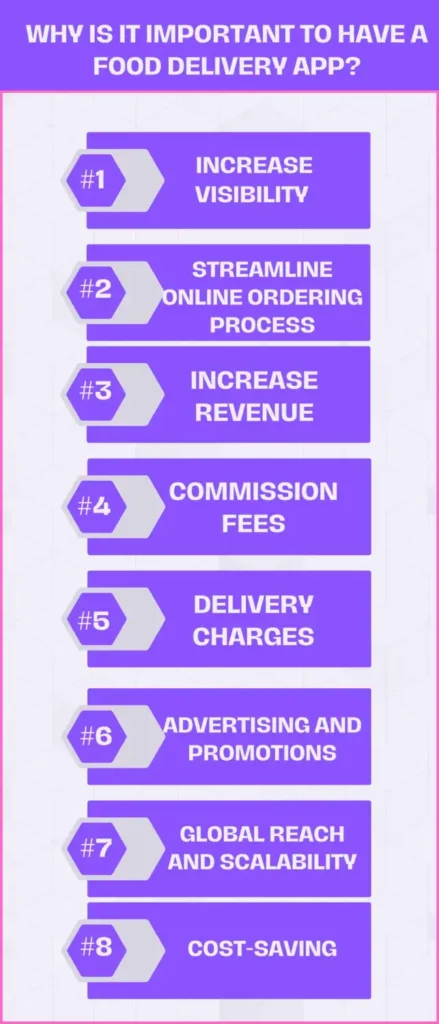
Increase Visibility
Nowadays, people prefer to order food online from the food apps. Therefore, having an online app can give you more chances to increase your visibility. An online presence of your restaurant can help you rank better and reach more customers.
With a dedicated food ordering and delivery platform, you can promote your restaurant to your target market and build customer trust.
Streamline Online Ordering Process
Restaurants can thrive in the competitive food delivery industry using a food delivery management app. They provide restaurants to streamline their order management system and eliminate the need for manual processing. Also, it reduces the chances of errors compared to phone orders.
Customers can also track their order deliveries on the mobile app, which provides a better experience. Due to this unique feature, customer satisfaction is improved and they stay informed about their order status.
Increase Revenue
One of the main benefits of white-label food delivery platforms is increased revenue. Food business owners can use technology to make their restaurants digital and boost their earnings for long-term success and expansion.
Using a food ordering app allows you to attract new customers who prefer the convenience of online ordering, leading to a significant increase in sales.
Moreover, having a mobile app provides you with access to various revenue-generating strategies, including:
Commission Fees: Platform owners can earn revenue by charging restaurants a fee for every order made through their platform. Typically, this fee is a percentage of the total order value.
Delivery Charges: In addition to costs such as rider salary, gas, and vehicle maintenance, you can include an additional service charge to the total delivery amount. This helps cover expenses and generate extra revenue.
Advertising and Promotions: Another way to generate revenue is by promoting other restaurants on your platform.
Global Reach and Scalability
By using a food delivery app, you can reach customers beyond your local area, regardless of their location. This becomes especially advantageous when you have plans to expand your business operations to different countries, as the app enables you to tap into new markets and serve a broader customer base.
Moreover, building a food delivery app eliminates the need to invest in physical stores. All you need to do to get your food delivery service up and running is to scale its resources to handle the increased traffic.
Cost-Saving
Creating your food delivery platform can help you save money. You don’t need to share your profits with third-party platforms. By using the third-party platforms, you have to pay around 30 to 40% additional costs.
What Features Do You Need in Your Food App?
Features also play a vital role in determining the cost. Before creating the food delivery app, you need to decide what features you add to your food delivery app.
Below is a list of features that you must add to your online ordering platform.
Customer App
Registration and login
Users create an account with an easy signup without filling out the lengthy forms. They need to provide their name, email address, and phone number.
Advanced search
This feature is important to develop an app like Foodpanda. It helps users browse different restaurants and cuisines according to pricing, ratings, and others.
Order tracking
With the help of this feature, users can track their orders in real time and know when they will be receiving them.
Rating and review
Make sure that your app has included the rating and review feature. This feature helps users to talk about their experiences and help others to make better choices.
Multiple payment choices
This is another feature that will affect your overall cost to develop a food delivery app. Providing a variety of payment options to users to increase the chances of getting more customers.
Push notifications
Users get notifications on the app about special deals, discounts, and offers.
Integrate social media
It is an option for users to link the app with their social network accounts. By enabling them to share the food images and reviews, more people will be aware of your restaurant.
Order customization
Users would love to customize their order according to their preferences. Therefore, add this feature to your food delivery app and attract more customers.
Order history
Users can check their past orders and reorder the items they liked without spending time to search the item.
Add favorite restaurants
This feature helps your customers add their favorite food items or restaurants to their favorite list for quick ordering.
Restaurant App
Order management
This feature is necessary and must be integrated into your food app. Restaurants can easily accept or reject orders due to their availability. This helps them to manage the order flow easily.
Menu management
It is a common feature of the food delivery management software where restaurants can add, edit, and update the menu items with prices, photos, and others.
Analytics and reporting
Restaurants can optimize operations by using analytics to gain information about their popular items, consumer preferences, and delivery timings.
Promotions and discounts
This feature will be helpful for restaurants to reward loyal customers and attract new customers. Also, with this feature restaurants can increase their sales and revenue.
Rider App
Account creation
Riders create an account on the rider delivery app by providing some information. They can edit and update their information easily.
Order history
This feature helps riders check the status of their orders delivered and pending.
Accept and manage deliveries
It is a must-have feature in the rider app. They can accept and reject deliveries as per their choice and their workload.
Route optimization
Riders can track their delivery time and route using the map integration and navigation tools.
Earning history
The rider can check their earnings and payments. Through this way, the riders can know about their daily earnings and timely payments.
In-app messaging
This feature helps riders to communicate with customers and update them about their orders. With this feature, there is no miscommunication between both parties.
Admin Dashboard
Restaurant management
From the admin dashboard, restaurants can manage their all operations from order placement to delivery.
Rider management
The riders can be easily managed by the admin and they track all their deliveries.
Customer management
It is another important feature of the admin dashboard. It allows admins to view and manage customer information such as contact details, order history, and preferences.
This information can be used to provide personalized services, handle customer queries or complaints, and maintain a good relationship with customers.
Payment management
It is a crucial part of any business, and the admin dashboard facilitates this process. Admins can view and manage payment information, including transaction details, pending payments, and refunds.
Discounts, offers, and coupons
The admin dashboard enables admins to create and manage promotions. They can set up discounts on specific items or order totals, create promotional offers for special occasions, and generate unique coupon codes. This helps boost sales, increase customer loyalty, and drive repeat business.
Which Technology Stack Used Food Delivery App Development?
Selecting the appropriate mobile app tech stack is essential for both mobile app security and user experience. The tech stack also impacts the cost if you want to create the DoorDash alternative app.
Let’s have a look at the technologies that will be used for your mobile app development so you can see how much it costs to create a food delivery app.
| Basis | Technology |
| Front-end | Flutter, React Native, Swift, Kotlin |
| Back-end | Ruby on Rails, Node.js, Django |
| Database | MongoDB, PostgreSQL, MySQL |
| API | RESTful API, GraphQL |
| Payment Gateway | Stripe, Braintree |
| Real-time Communication | Firebase, Socket.io |
| Hosting | AWS, Google Cloud Platform |
| Push Notifications | Apple Push Notification Service, Firebase Cloud Messaging |
| Analytics | Google Analytics |
The actual technology stack can vary depending on specific requirements, preferences, and the development team’s expertise.
What Development Platforms Do You Use For a Food Delivery App?
Selecting the development platform to develop your food app is an important factor to consider and can affect the cost of making a food delivery app.
Here are some commonly used development platforms for food delivery apps.
Native App Development
iOS: Swift programming language using Xcode IDE.
Android: Java or Kotlin programming language using Android Studio IDE.
Cross-Platform App Development
React Native: JavaScript-based framework developed by Facebook that allows you to build apps for both iOS and Android using a single codebase.
Flutter: Open-source UI toolkit developed by Google that enables you to create apps for both iOS and Android using a single codebase.
Steps for Food Delivery App Development
Below are some steps to help you in the food delivery app development phase.
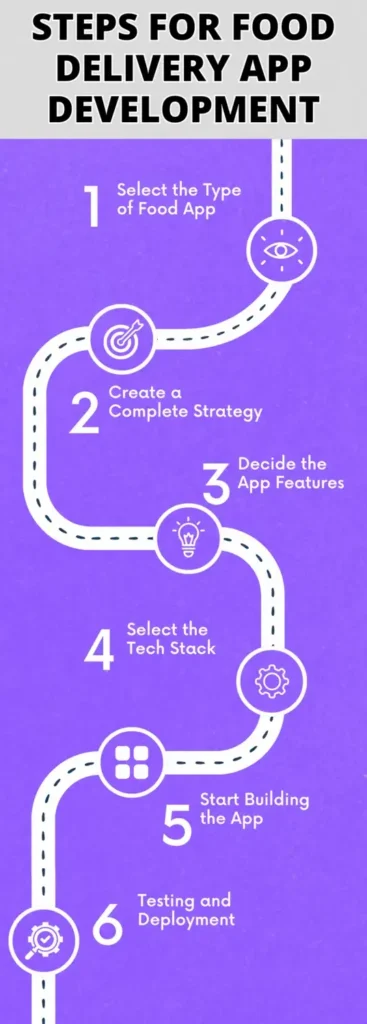
1. Select the Type of Food App
Determine the type of food delivery service you want to offer – food delivery, grocery delivery, etc. Then, identify your target audience and their specific needs. Also, research the competition and analyze their offerings to find gaps in the market.
2. Create a Complete Strategy
Define your business model and revenue streams (commission-based, subscription, etc.). In addition, develop a marketing strategy to attract and retain customers. Determine the key performance indicators (KPIs) to track the success of your app.
3. Decide the App Features
Select the main features of your app. Make sure to add those features that are relevant to your users.
Core features: User registration, menu browsing, order placement, payment integration, order tracking, and delivery status updates.
Advanced features: Push notifications, in-app chat, order history, personalized recommendations, loyalty programs, and integration with third-party services.
4. Select the Tech Stack
The right tech stack builds the foundation of the app. Therefore, choose it carefully and select the appropriate programming languages and frameworks for your app. Make sure to select those that are relevant, match your app requirements, and the development team has expertise.
5. Start Building the App
Design the user interface (UI) and user experience (UX) based on your target audience’s preferences. Develop the frontend and backend components of the app. Implement the core and advanced features incrementally.
6. Testing and Deployment
Conduct thorough testing to identify and fix any bugs or issues. Perform user acceptance testing to ensure the app meets the requirements and provides a smooth experience. Optimize the app for performance, security, and scalability.
In addition, deploy the app on the relevant app stores (Apple App Store and Google Play Store). Continuously monitor the app’s performance and gather user feedback to make improvements.
Tips to Reduce the Cost of Food Delivery App Development
Below are some tips to help you reduce the cost of food delivery app development.
- Try to build an MVP (minimum viable product) and add only core features. This approach will help you build your app at a minimal cost.
- Use free and open-source libraries and development frameworks for app development. They save you money on licensing fees compared to proprietary software.
- Develop an app for just one platform and then expand to the other if needed.
- Hire developers from the regions that work at lower hourly rates. However, check their profile, experience, and portfolio and then make a final decision.
- Serverless architecture and cloud-based services can let you scale your app effectively without incurring significant upfront infrastructure costs. Incorporate cloud-based technologies as much as possible into your food delivery app.
Supercharge your deliveries with Enatega.
Get Started NowFAQs
1. How much does it cost to maintain an app?
The cost of maintaining the app depends on these factors:
- How frequently do you update the app?
- The tech stack you use
- The size of the development team
- The complexity of the app
2. Does it cost to publish an app?
The cost of publishing an app on Google Play or Apple App Store can vary. Google charges a $25 one-time fee to release an app. Whereas, $99 is a yearly fee to release an app on the Apple Store.
3. How to build a delivery app?
Below are some steps to help you build a delivery app.
- Conduct market research
- Select the food delivery business model
- Decide the app features
- Choose the tech stack
- Start the app development
- Testing and launching the app
4. How much does it cost to build an app like DoorDash?
The cost to build an app like DoorDash can vary widely, ranging anywhere from $50,000 to $500,000 or more, depending on the features, complexity, and platform(s) targeted.
5. Do delivery apps make money?
Yes, delivery apps can make money, primarily through commissions charged to restaurants and fees from customers. They often have multiple revenue streams, including subscription services, advertising, and delivery fees. However, profitability varies widely depending on market competition, operational costs, and user engagement.
Conclusion
Creating the food delivery app provides you with several opportunities in the food delivery market. It is a game-changer and helps you to grow your business online.
Moreover, you are well-versed with the cost of building a food delivery app. However, in case you are thinking of developing a food delivery app like Foodpanda or UberEats, consult a food delivery app development company, Enatega. We can help you to grow in the food delivery market.
You can schedule a call with us and get a free consultation for your food ordering and delivery solution.








